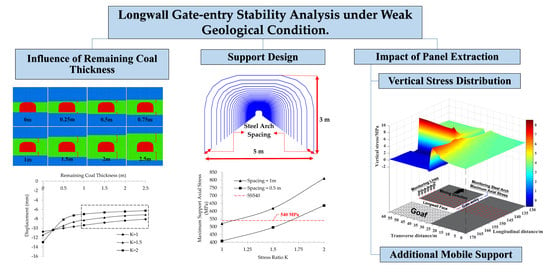Numerical Analysis of Longwall Gate-Entry Stability under Weak Geological Condition: A Case Study of an Indonesian Coal Mine
Abstract
:1. Introduction
2. General Overview of the Targeted Indonesia Coal Mine
3. Modeling
3.1. General Model Description
- Construct model geometry (half-width of the panel is modeled to reduce the model analyzing time).
- Apply boundary condition, assign mechanical properties, determine initial stress condition, and analyze for the initial state.
- Excavate gate-entry and install steel arch 200 m.
- Monitor maximum axial stress of steel arch and roof displacement
- Excavate longwall panel for 100 m.
- Monitor maximum support axial stress
3.2. Goaf Modelling
3.3. Modeling for Shield Support
3.4. Model Validation
4. Results and Discussions
4.1. Stability of Gate-Entry under the Influence of the Remaining Coal Thickness (RCT)
4.2. Gate-Entry Stability during Gate Development
4.3. Gate-Entry Stability during Panel Extraction
4.3.1. Vertical Stress Distribution
4.3.2. Maximum Axial Stress of Each Individual Support along Gate-Entry
5. Conclusions
- (1)
- In the shallow depth where the rock is relatively weaker, the optimum thickness of 1 m of RCT can help to improve gate-entry stability by extending the overall support capacity, which is suitable for stress ratio 1.6 when adopting 1 m spacing, to withstand a higher stress ratio up to 1.9 when using the same spacing configuration.
- (2)
- The appropriate support configuration for 150 m of depth is 0.5 m spacing where the stress ratio is 1.6. A narrower spacing or incorporation of rock bolt or shotcrete is required in the area where the stress ratio is higher than 1.6.
- (3)
- Results from the vertical stress are in line with the results of maximum support axial stress. During panel excavation, for both cases, that is, 100 m of depth with 1 m spacing and 150 m of depth with 0.5 m spacing support configuration, the unstable distance along gate-entry is approximately 10 m from the longwall face.
Author Contributions
Funding
Conflicts of Interest
References
- Sasaoka, T.; Hamanaka, A.; Shimada, H.; Matsui, K.; Lin, N.Z.; Sulistianto, B. Punch multi-slice longwall mining system for thick coal seam under weak geological conditions. J. Geol. Resour. Eng. 2015, 1, 28–36. [Google Scholar]
- Sasaoka, T.; Karian, T.; Hamanaka, A.; Shimada, H.; Matsui, K. Application of highwall mining system in weak geological condition. Int. J. Coal Sci. Technol. 2016, 3, 311–321. [Google Scholar] [CrossRef] [Green Version]
- Pongpanya, P.; Sasaoka, T.; Shimada, H.; Hamanaka, A.; Wahyudi, S. Numerical Study on Effect of Longwall Mining on Stability of Main Roadway under Weak Ground Conditions in Indonesia. J. Geol. Resour. Eng. 2017, 3, 93–104. [Google Scholar]
- Hoek, E.; Brown, E.T. Practical estimates of rock mass strength. Int. J. Rock Mech. Min. Sci. 1997, 34, 1165–1186. [Google Scholar] [CrossRef]
- Bieniawski, Z.T. Estimating the strength of rock materials. J. S. Afr. Inst. Min. Metall. 1974, 74, 312–320. [Google Scholar] [CrossRef]
- Guney, A.; Gul, M. Analysis of surface subsidence due to longwall mining under weak geological conditions: Turgut basin of Yatağan-Muğla (Turkey) case study. Int. J. Min. Reclam. Environ. 2019, 33, 445–461. [Google Scholar] [CrossRef]
- Cui, X.; Zhao, Y.; Wang, G.; Zhang, B.; Li, C. Calculation of Residual Surface Subsidence Above Abandoned Longwall Coal Mining. Sustainability 2020, 12, 1528. [Google Scholar] [CrossRef] [Green Version]
- Yang, R.; Zhu, Y.; Li, Y.; Li, W.; Lin, H. Coal pillar size design and surrounding rock control techniques in deep longwall entry. Arab. J. Geosci. 2020, 13, 1–14. [Google Scholar] [CrossRef]
- Li, Y.; Lei, M.; Wang, H.; Li, C.; Li, W.; Tao, Y.; Wang, J. Abutment pressure distribution for longwall face mining through abandoned roadways. Int. J. Min. Sci. Technol. 2019, 29, 59–64. [Google Scholar] [CrossRef]
- Hong-Pu, K.; Jian, L.; Yong-Zheng, W. Development of high pretensioned and intensive supporting system and its application in coal mine roadways. Procedia Earth Planet. Sci. 2009, 1, 479–485. [Google Scholar] [CrossRef] [Green Version]
- Jiao, Y.-Y.; Song, L.; Wang, X.-Z.; Coffi Adoko, A. Improvement of the U-shaped steel sets for supporting the roadways in loose thick coal seam. Int. J. Rock Mech. Min. Sci. 2013, 60, 19–25. [Google Scholar] [CrossRef]
- Meng, Q.; Han, L.; Qiao, W.; Lin, D.; Fan, J. Support technology for mine roadways in extreme weakly cemented strata and its application. Int. J. Min. Sci. Technol. 2014, 24, 157–164. [Google Scholar] [CrossRef]
- Phanthoudeth, P. Appropriate Design of Longwall Coal Mining System under Weak Geological Conditions in Indonesia; Kyushu University: Fukuoka, Japan, 2018. [Google Scholar]
- Toraño, J.; Díez, R.R.G.; Rivas Cid, J.M.; Barciella, M.M.C. FEM modeling of roadways driven in a fractured rock mass under a longwall influence. Comput. Geotech. 2002, 29, 411–431. [Google Scholar] [CrossRef]
- Brune, J.; Sapko, M. A modeling study on longwall tailgate ventilation. In Proceedings of the 14th United States/North American Mine Ventilation Symposium, Salt Lake City, UT, USA, 17–20 June 2012. [Google Scholar]
- Jiang, L.; Sainoki, A.; Mitri, H.S.; Ma, N.; Liu, H.; Hao, Z. Influence of fracture-induced weakening on coal mine gateroad stability. Int. J. Rock Mech. Min. Sci. 2016, 88, 307–317. [Google Scholar] [CrossRef]
- Suchowerska, A.M.; Merifield, R.S.; Carter, J.P. Vertical stress changes in multi-seam mining under supercritical longwall panels. Int. J. Rock Mech. Min. Sci. 2013, 61, 306–320. [Google Scholar] [CrossRef]
- Ozfirat, M.; Simsir, F.; Gonen, A. A brief comparison of longwall methods used at mining of thick coal seams. In Proceedings of the 19th International Mining Congress and Fair, Izmir, Turkey, 9–12 June 2005. [Google Scholar]
- Hebblewhite, B. Status and prospects of underground thick coal seam mining methods. In Proceedings of the 19th International Mining Congress and Fair, Izmir, Turkey, 9–12 June 2005. [Google Scholar]
- Matsui, K.; Sasaoka, T.; Shimada, H.; Furukawa, H.; Takamoto, H.; Ichinose, M. Some considerations in underground mining systems for extra thick coal seams. Coal Int. 2011, 259, 38–43. [Google Scholar]
- Wang, J.C.; Wang, Z.H.; Yang, S.L. Stress analysis of longwall top-coal caving face adjacent to the gob. Int. J. Min. Reclam. Environ. 2020, 34, 476–497. [Google Scholar] [CrossRef]
- Zarlin, N.; Sasaoka, T.; Shimada, H.; Matsui, K. Numerical study on an applicable underground mining method for soft extra-thick coal seams in Thailand. J. Eng. 2012, 4, 739–745. [Google Scholar] [CrossRef] [Green Version]
- Itasca_Consulting_Group. FLAC3D 5.0 Manual; Itasca Consulting Group: Minneapolis, Minnesota, 2012. [Google Scholar]
- Wang, J.; Yang, S.; Li, Y.; Wang, Z. A dynamic method to determine the supports capacity in longwall coal mining. Int. J. Min. Reclam. Environ. 2015, 29, 277–288. [Google Scholar] [CrossRef]
- Thin, I.G.T.; Pine, R.J.; Trueman, R. Numerical modelling as an aid to the determination of the stress distribution in the goaf due to longwall coal mining. Int. J. Rock Mech. Min. 1993, 30, 1403–1409. [Google Scholar] [CrossRef]
- Song, G.; Chugh, Y. 3D analysis of longwall face stability in thick coal seams. J. S. Afr. Inst. Min. Metall. 2018, 118, 131–142. [Google Scholar] [CrossRef]
- Zhao, T.; Liu, C.; Yetilmezsoy, K.; Gong, P.; Chen, D.; Yi, K. Segmental adjustment of hydraulic support setting load in hard and thick coal wall weakening: A study of numerical simulation and field measurement. J. Geophys. Eng. 2018, 15, 2481–2491. [Google Scholar] [CrossRef] [Green Version]
- Cheng, Y.; Wang, J.; Xie, G.; Wei, W. Three-dimensional analysis of coal barrier pillars in tailgate area adjacent to the fully mechanized top caving mining face. J. Rock Mech. Min. 2010, 47, 1372–1383. [Google Scholar] [CrossRef]
- Yavuz, H. An estimation method for cover pressure re-establishment distance and pressure distribution in the goaf of longwall coal mines. J. Rock Mech. Min. 2004, 41, 193–205. [Google Scholar] [CrossRef]
- Wang, Z.-H.; Yang, J.-H.; Meng, H. Mechanism and controlling technology of rib spalling in mining face with large cutting height passing through fault. J. China Coal Soc. 2015, 40, 42–49. [Google Scholar]
- Song, G.; Chugh, Y.P.; Wang, J. A numerical modelling study of longwall face stability in mining thick coal seams in China. J. Min. Miner. Eng. 2017, 8, 35–55. [Google Scholar] [CrossRef]
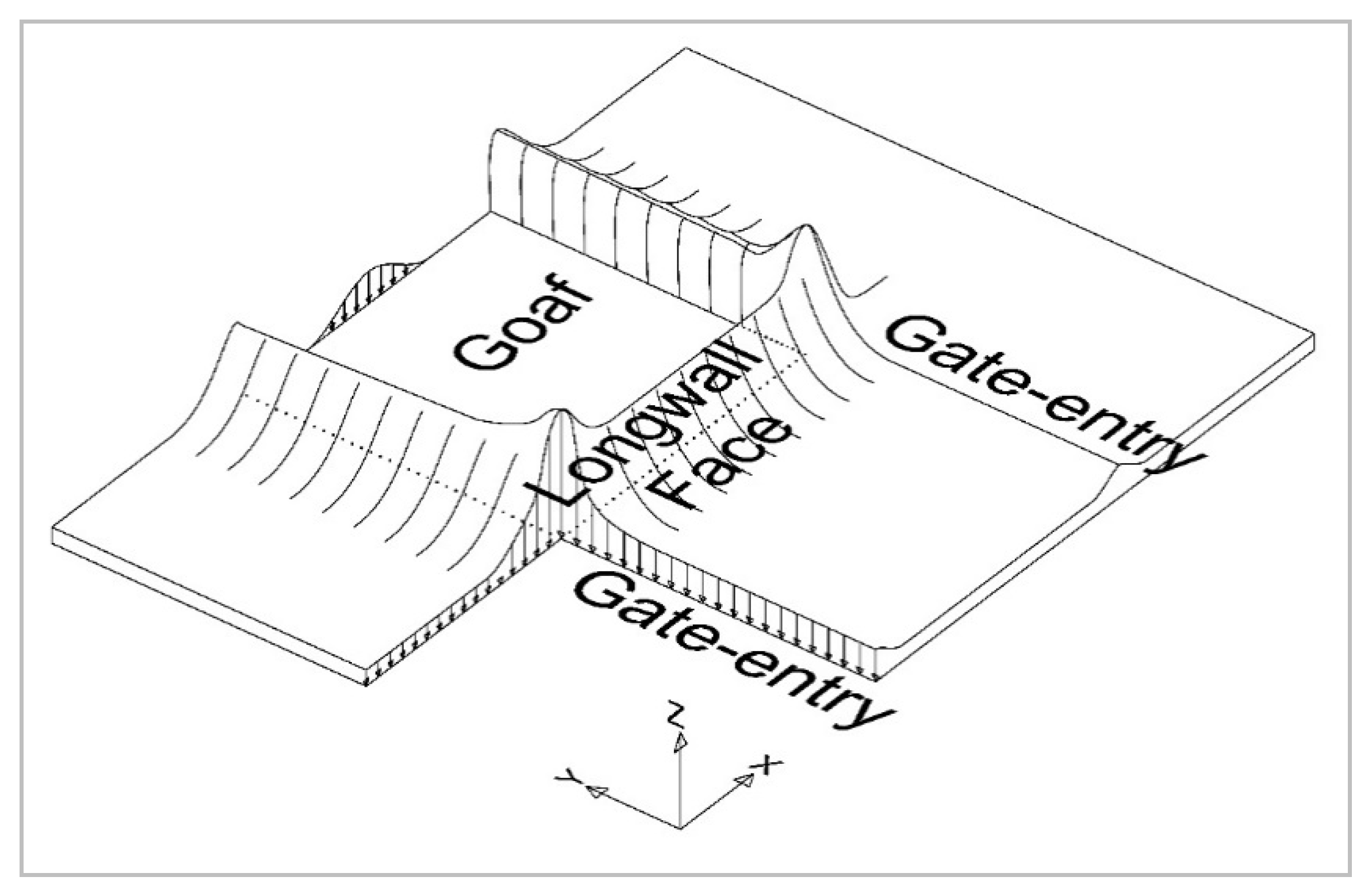
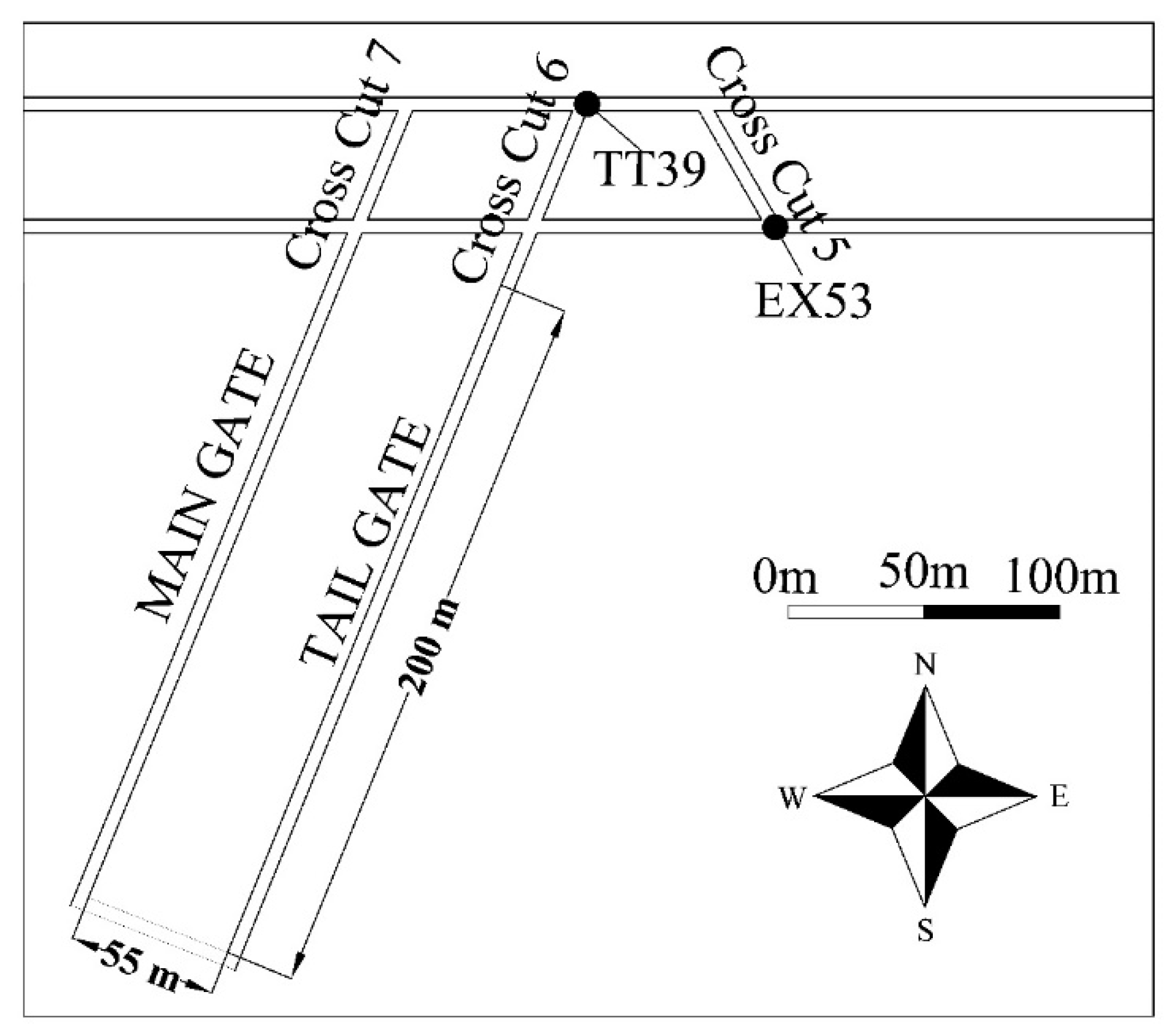
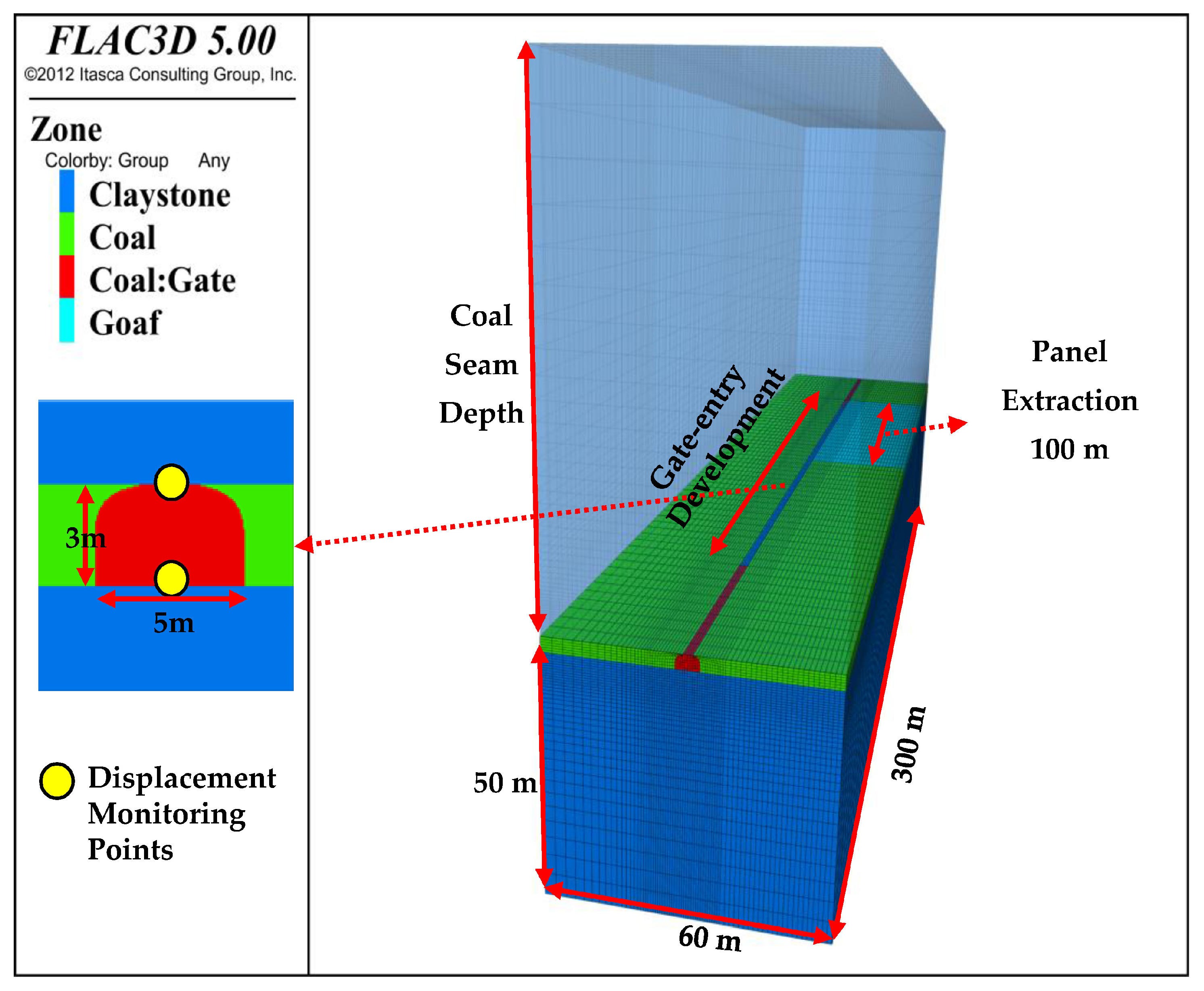
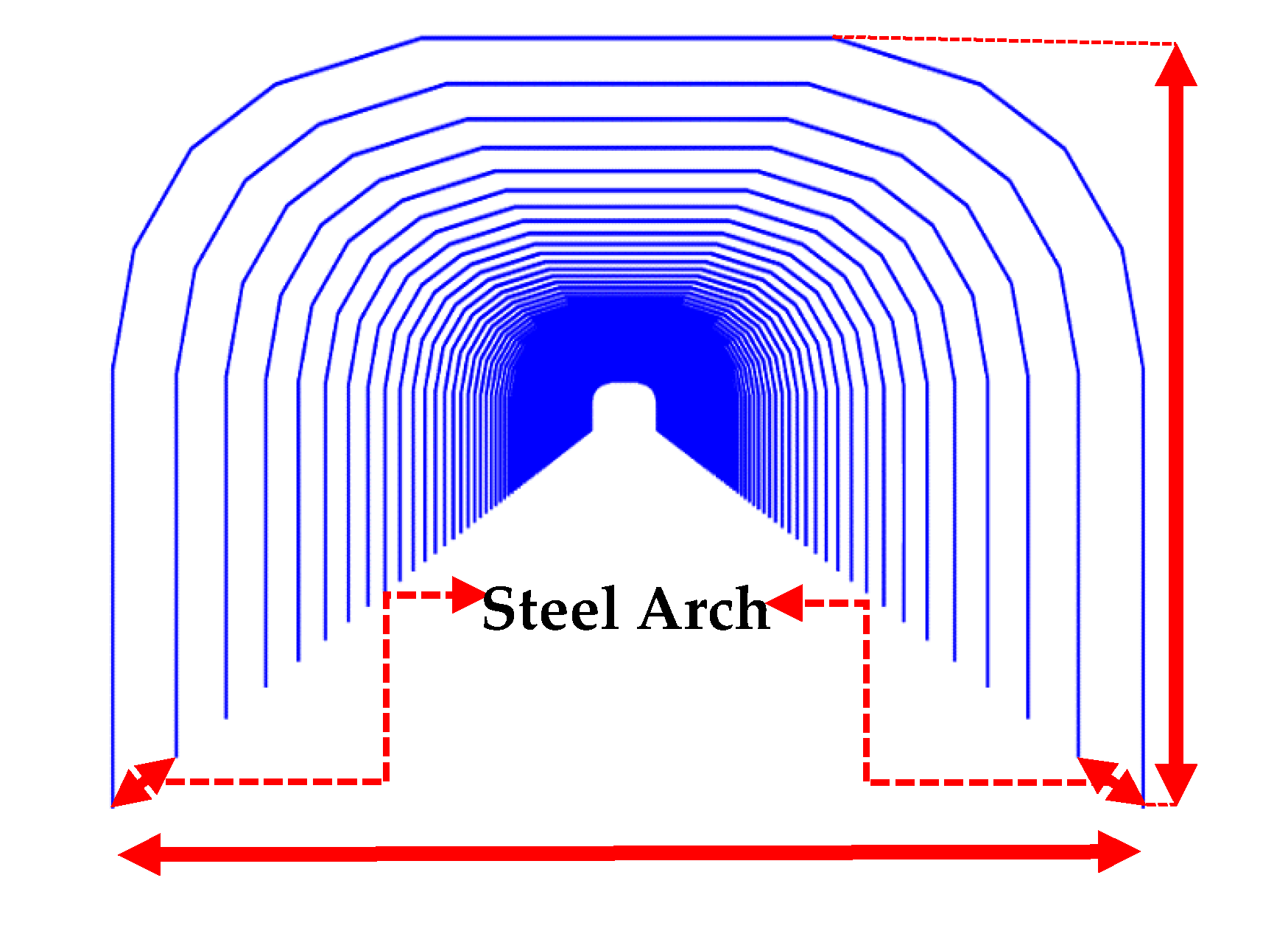
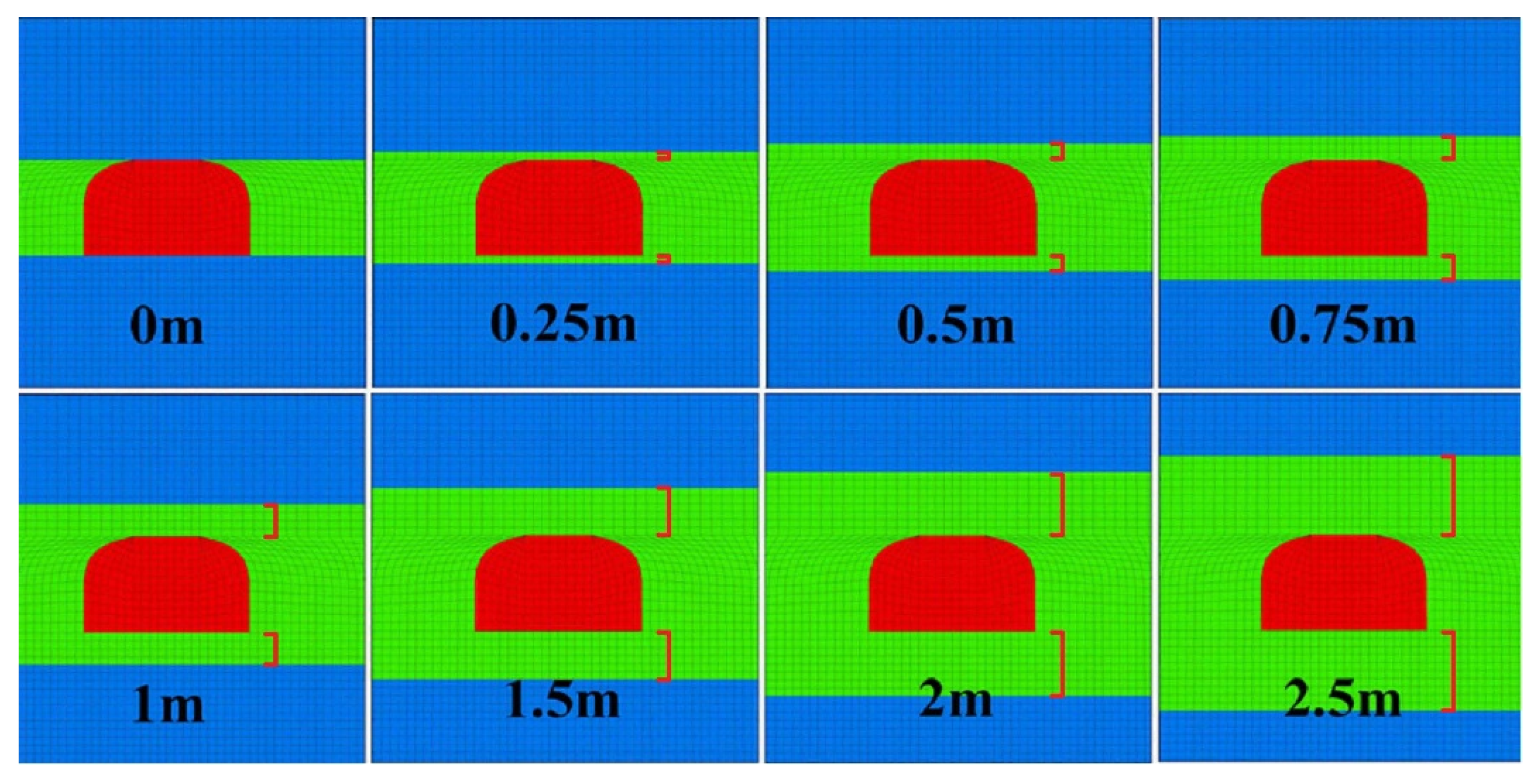
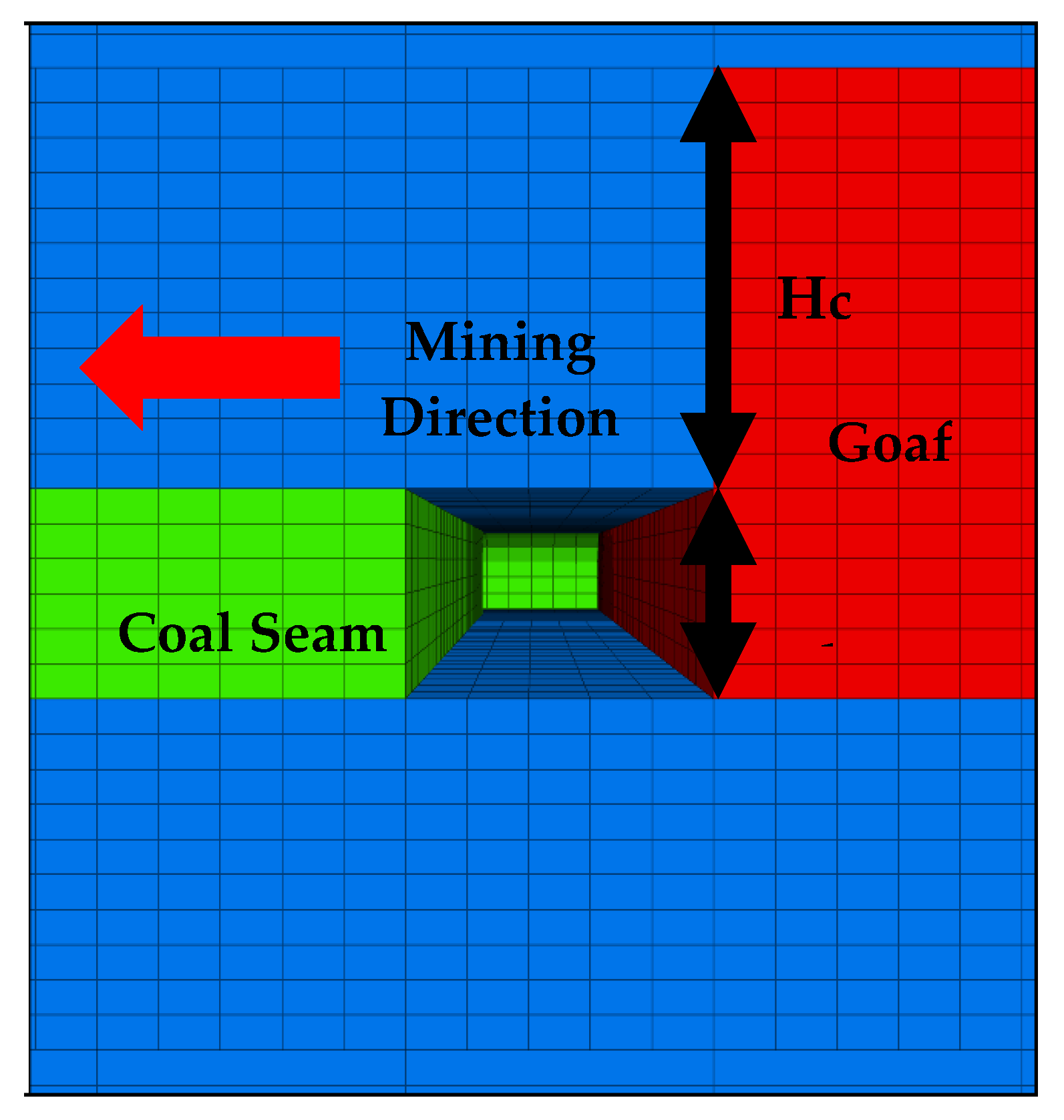


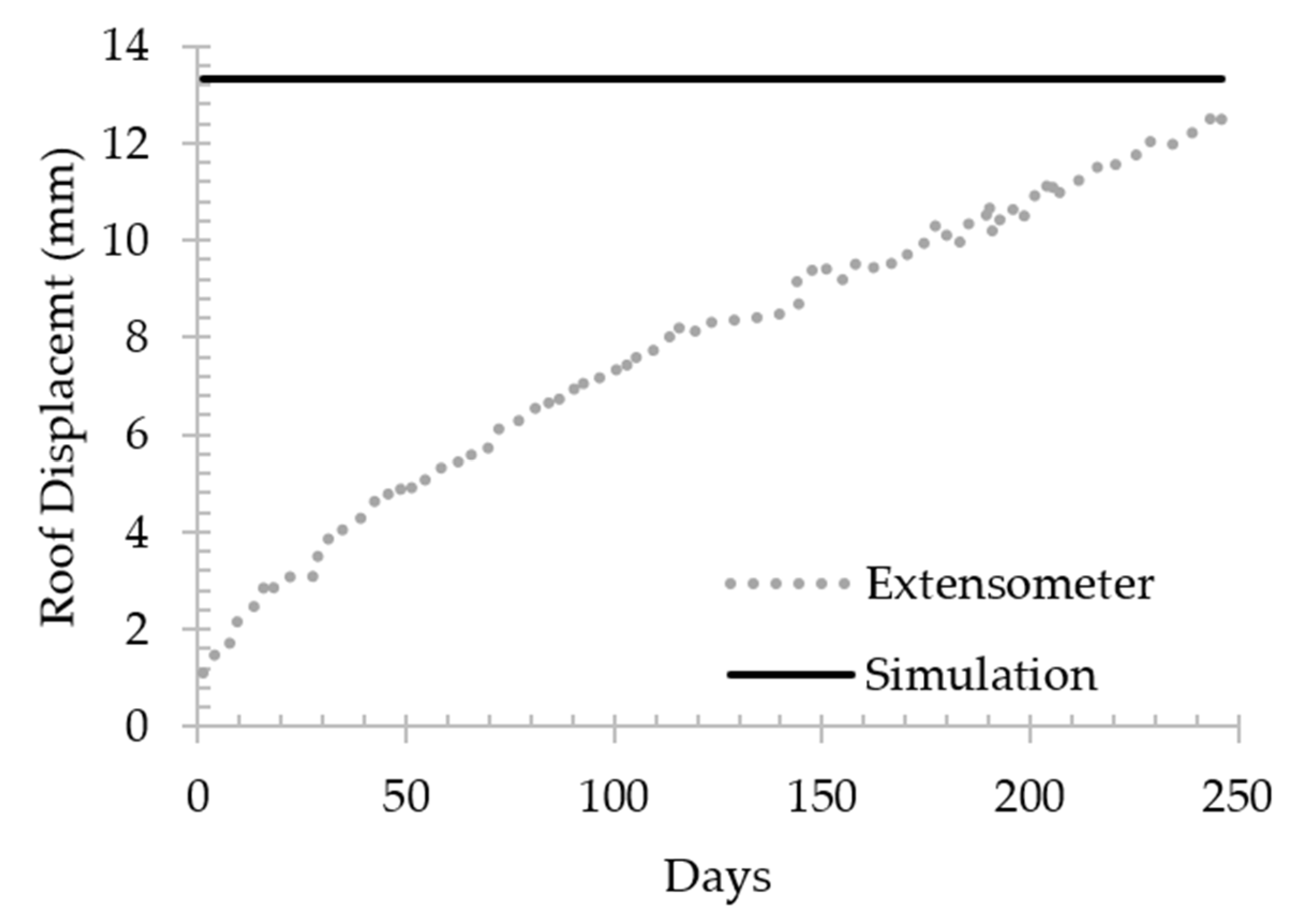
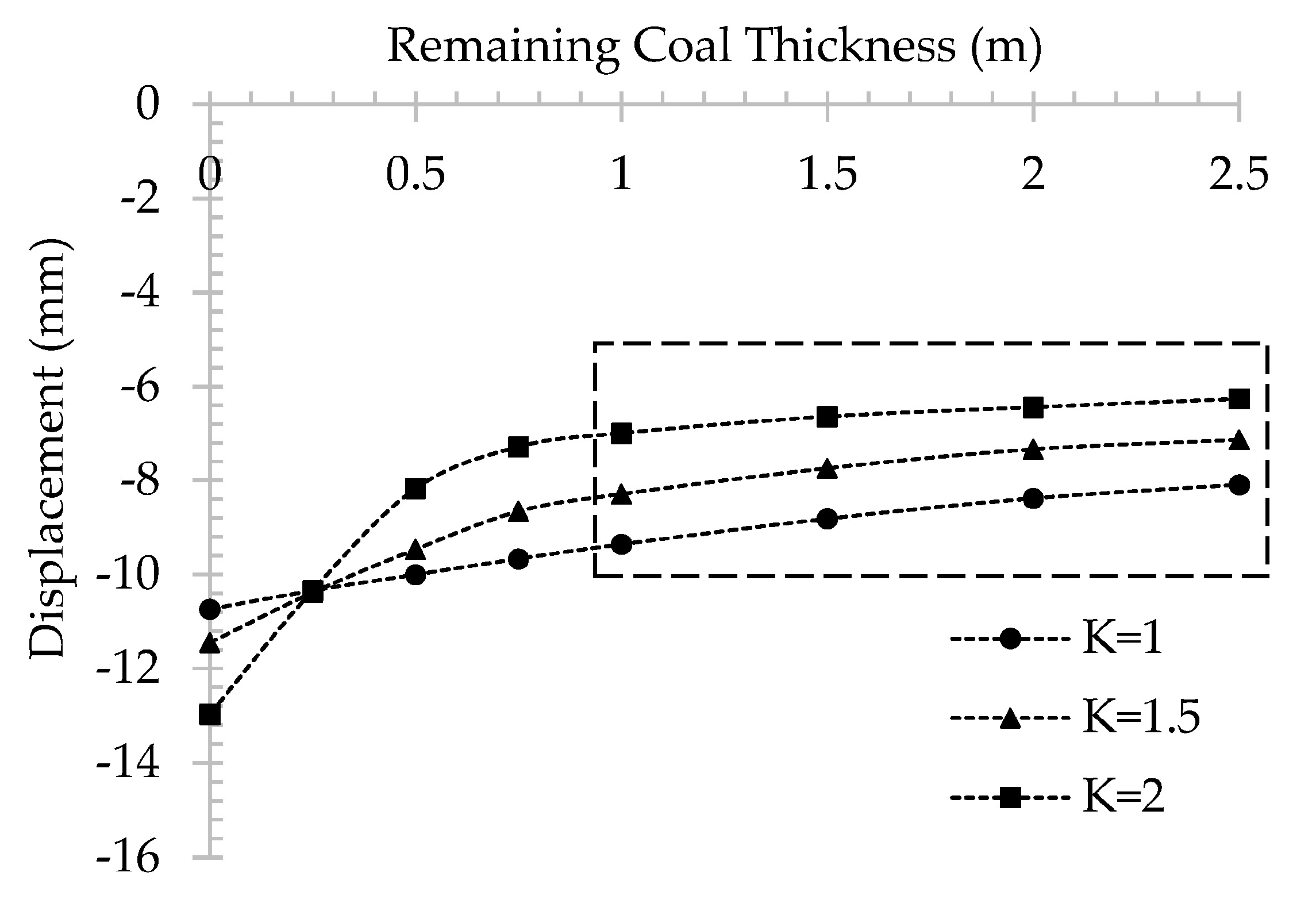

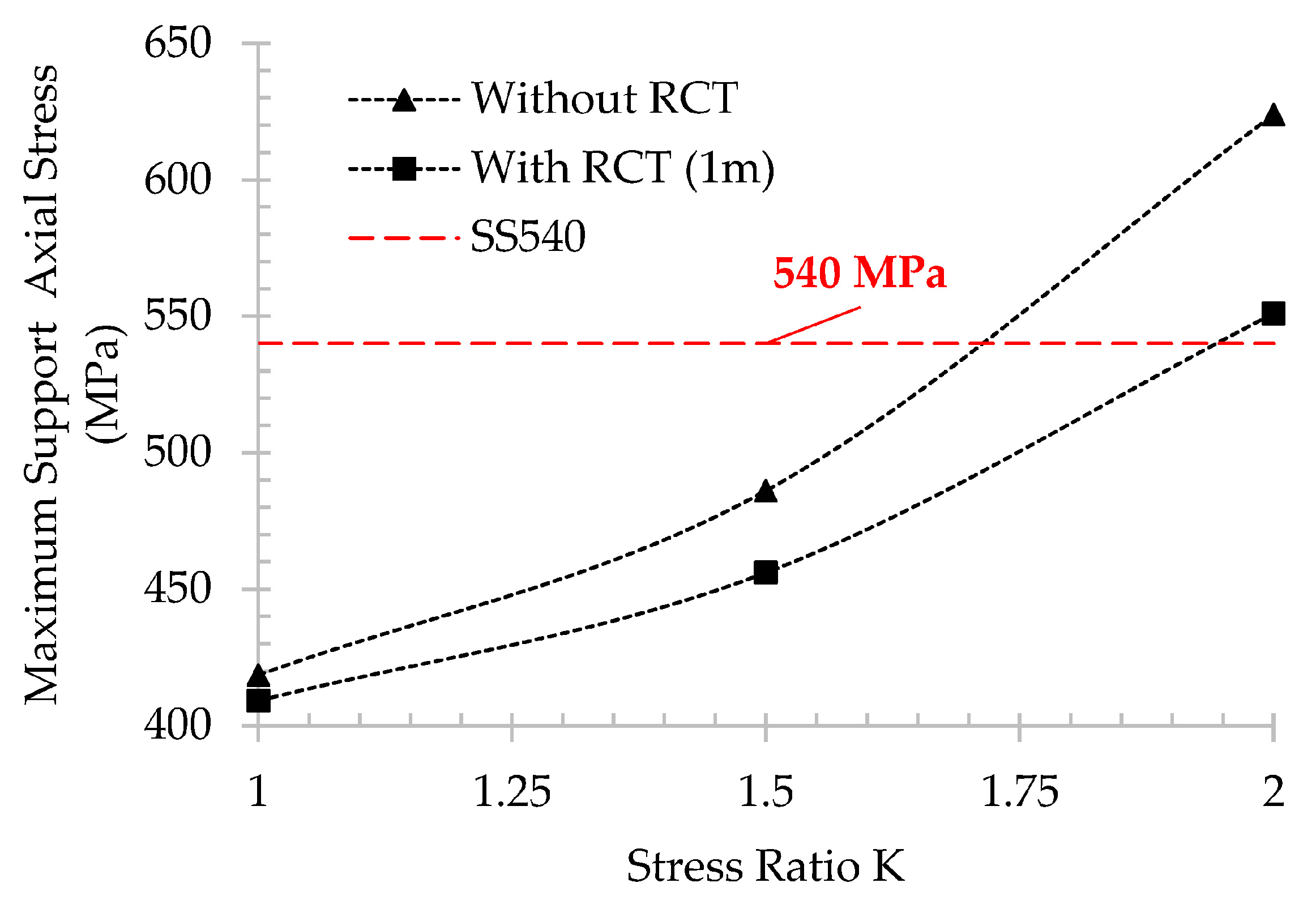
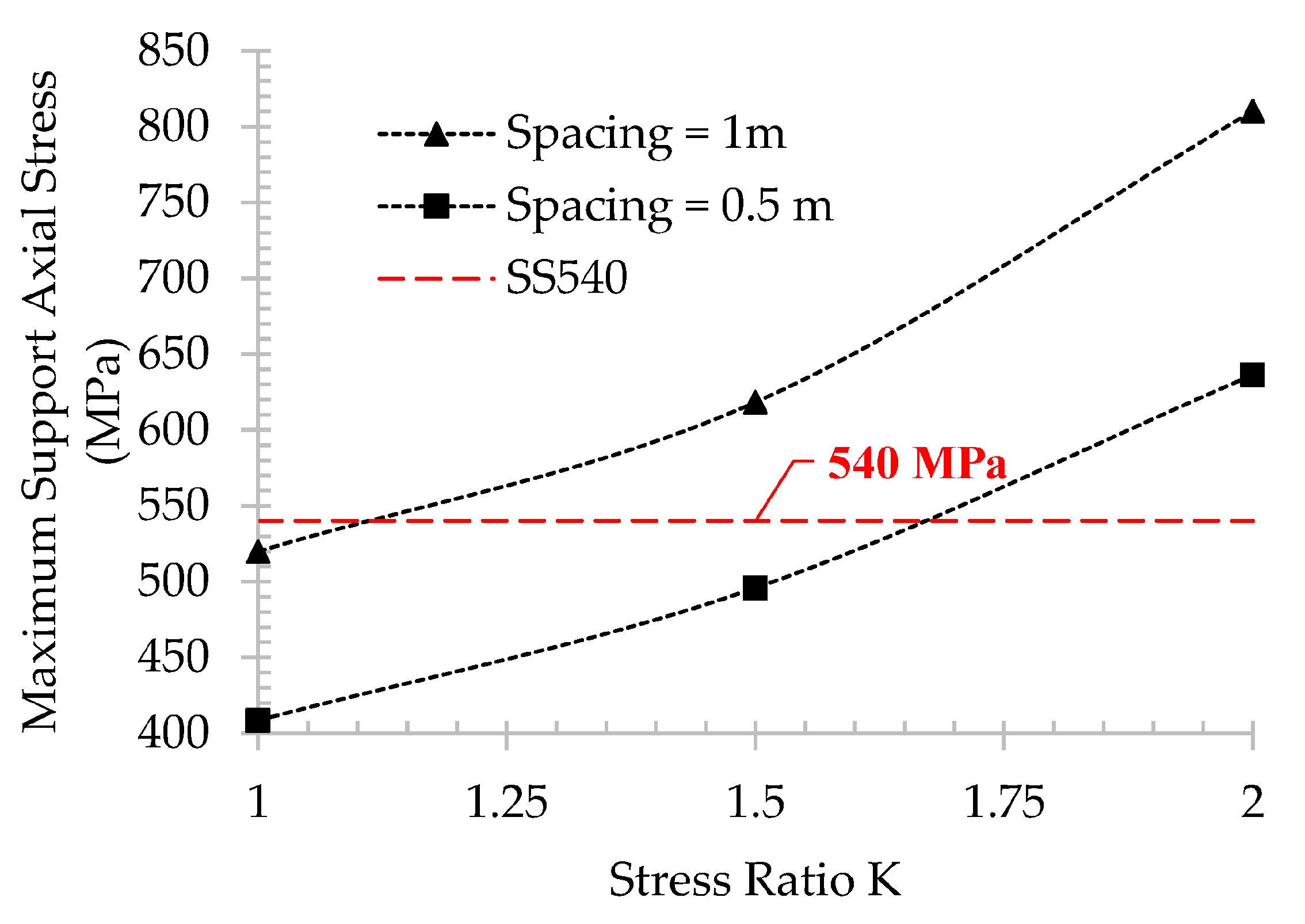
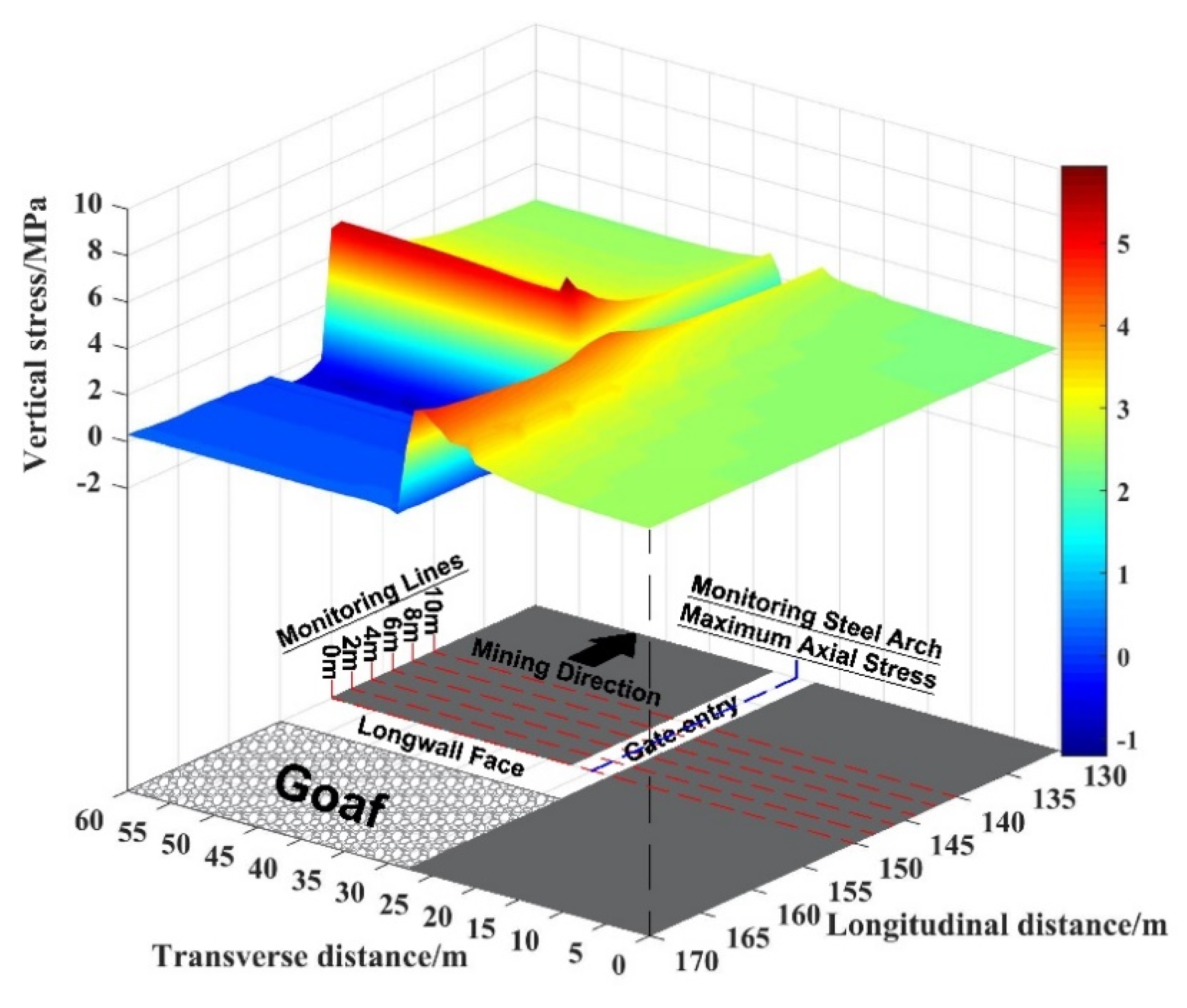

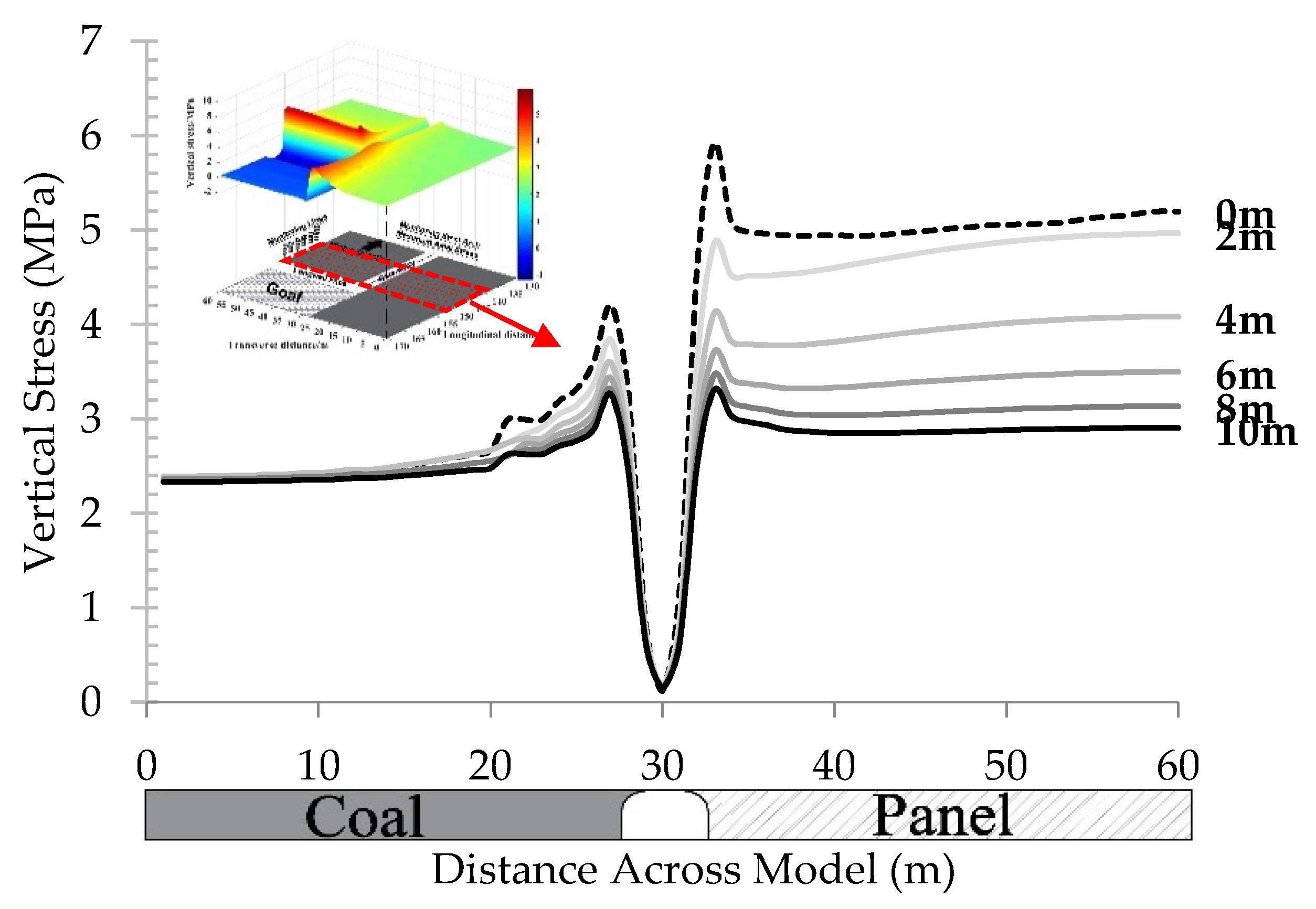
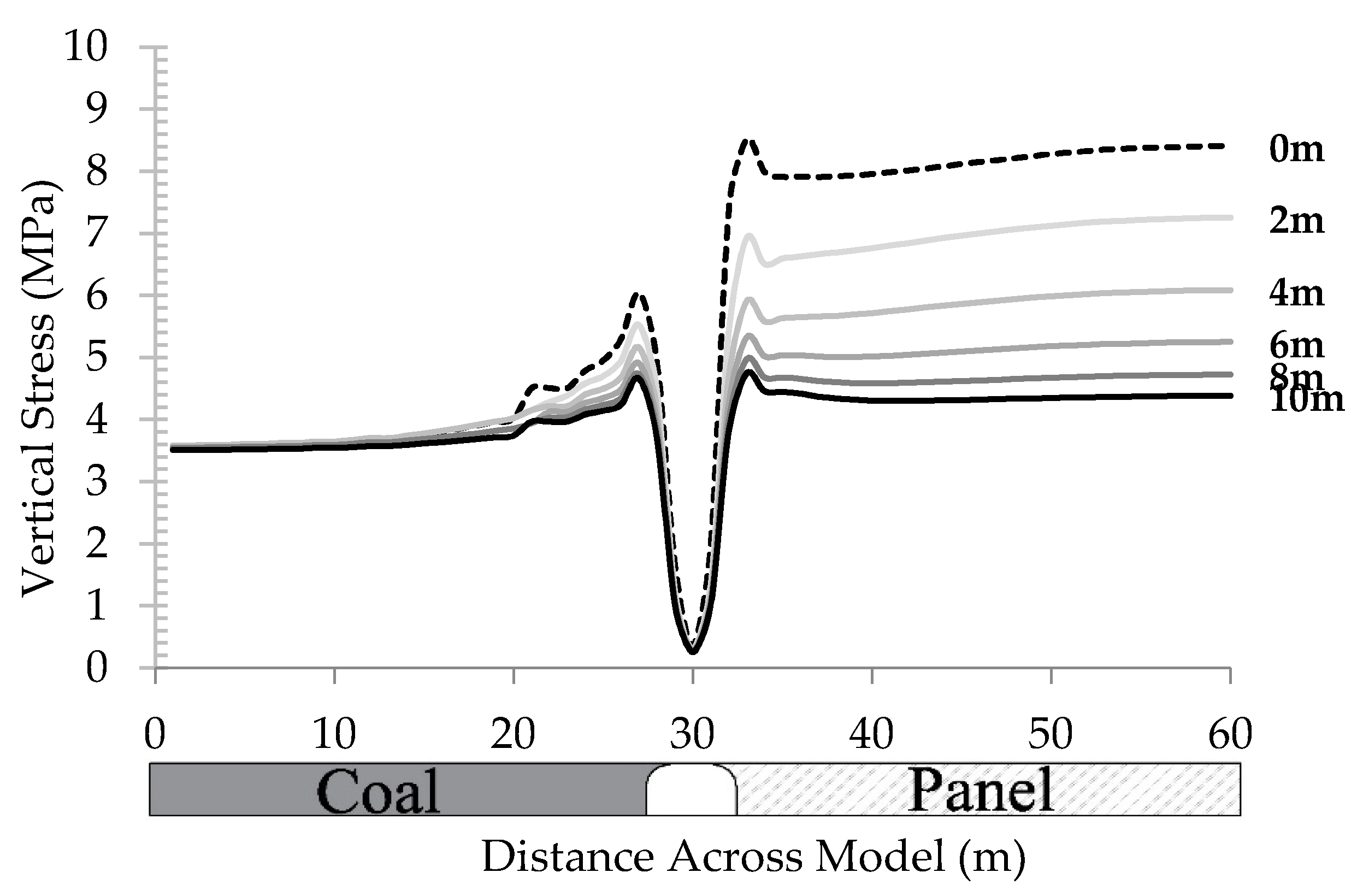
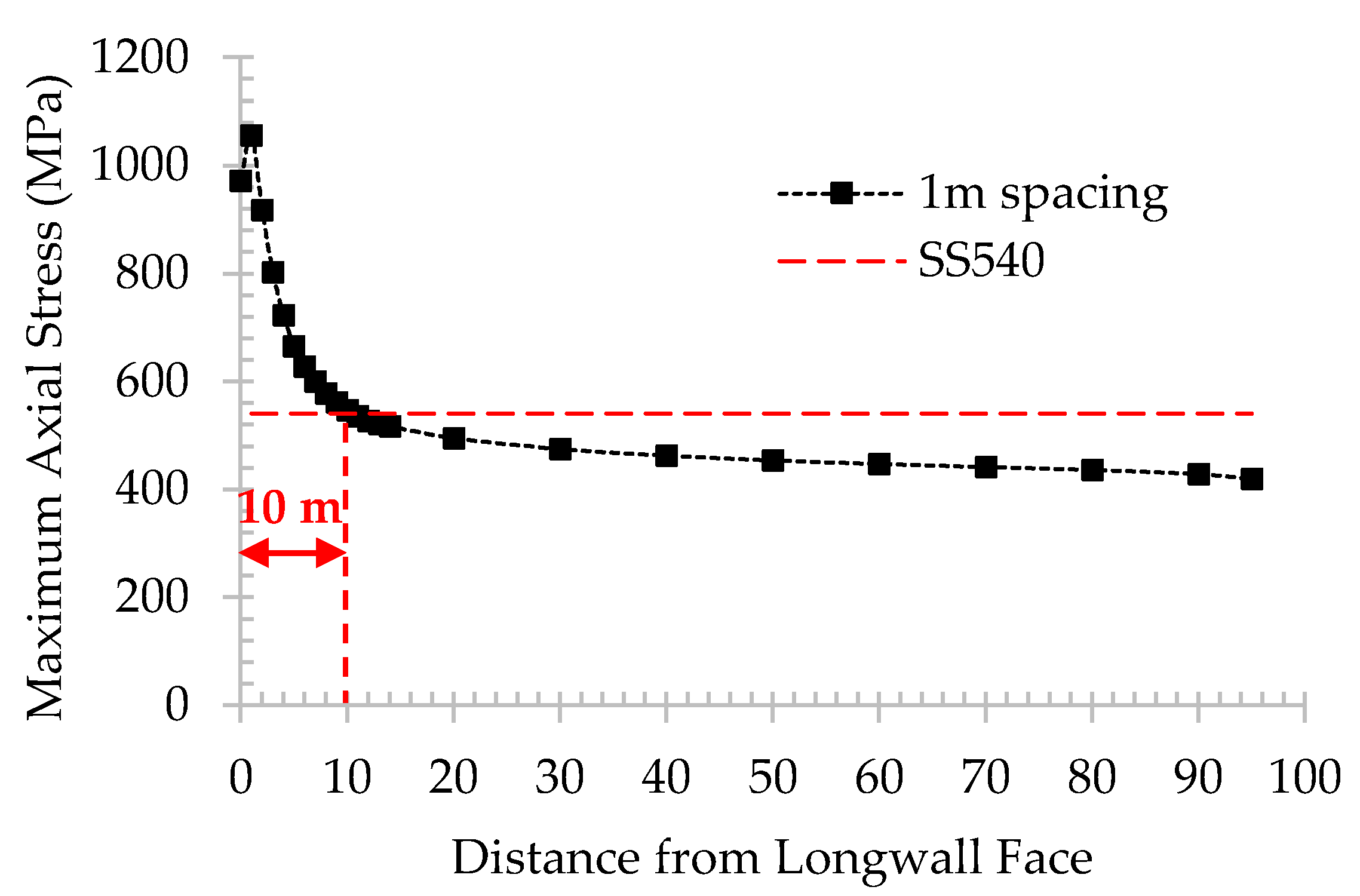
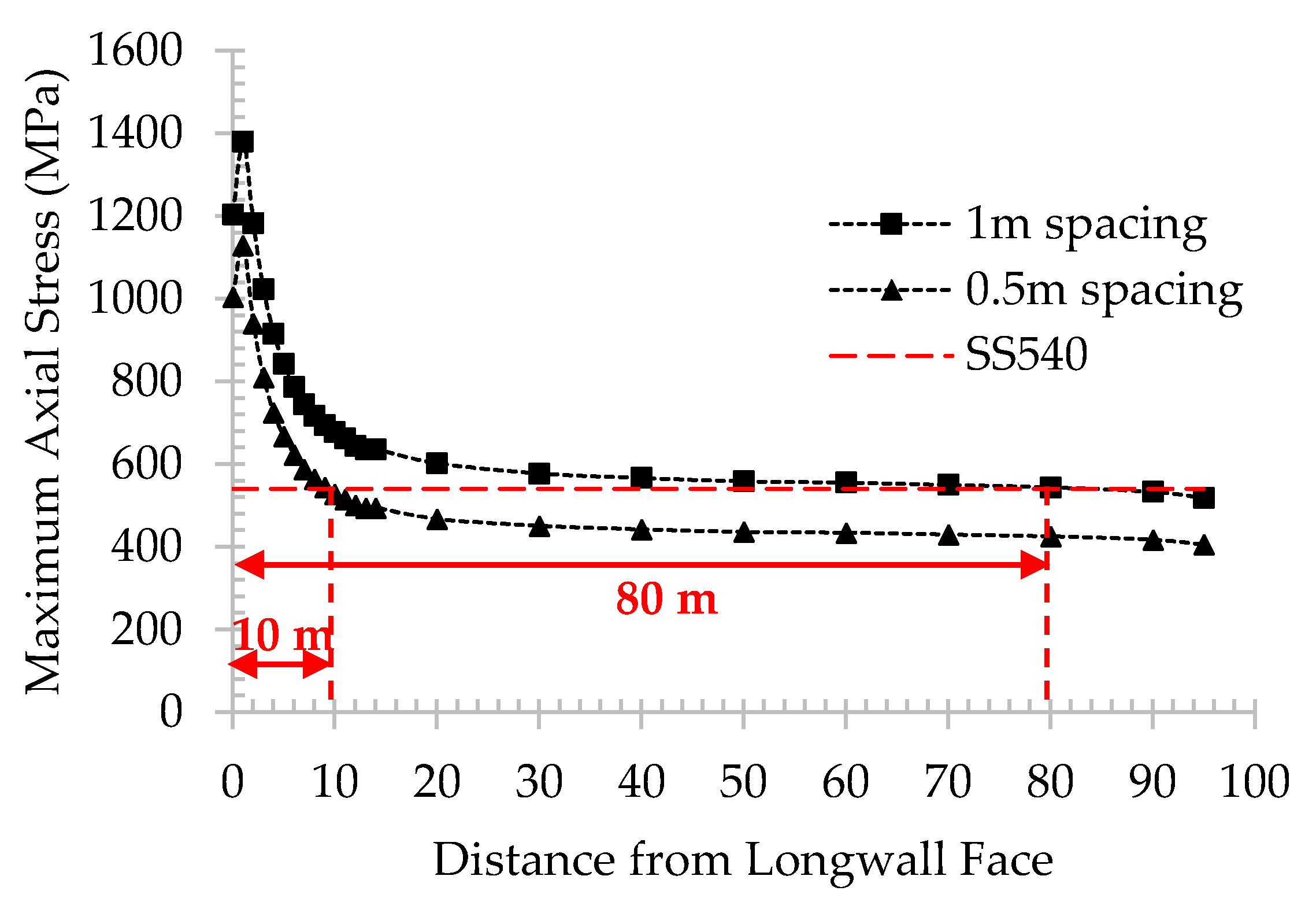
| Rock | Claystone (100 m of Depth) | Claystone (150 m of Depth) | Coal Seam | Goaf Area |
|---|---|---|---|---|
| Uniaxial Compressive Strength (MPa) | 4.84 | 6.96 | 8.16 | - |
| Density (kg/m3) | 2108 | 2121 | 1380 | 1700 |
| E (MPa) | 805 | 1344 | 1300 | 15 |
| υ | 0.28 | 0.28 | 0.32 | 0.25 |
| C (MPa) | 0.6 | 0.84 | 2.63 | 0.001 |
| φ (°) | 37.5 | 41.8 | 45.6 | 25 |
| σT (MPa) | 0.52 | 0.66 | 0.58 | - |
| Density (kg/m3) | E (GPa) | υ | Cross Area (cm2) | Yield (MPa) | Iy (×10−8 m4) | Iz (×10−8 m4) | J (×10−8 m4) |
|---|---|---|---|---|---|---|---|
| 7800 | 200 | 0.3 | 36.51 | 540 | 732 | 154 | 22 |
| Lithology | Uniaxial Compressive Strength (MPa) | c1 | c2 |
|---|---|---|---|
| Strong | >40 | 2.1 | 16 |
| Medium | 20–40 | 4.7 | 19 |
| Weak | >20 | 6.2 | 32 |
© 2020 by the authors. Licensee MDPI, Basel, Switzerland. This article is an open access article distributed under the terms and conditions of the Creative Commons Attribution (CC BY) license (http://creativecommons.org/licenses/by/4.0/).
Share and Cite
Sasaoka, T.; Mao, P.; Shimada, H.; Hamanaka, A.; Oya, J. Numerical Analysis of Longwall Gate-Entry Stability under Weak Geological Condition: A Case Study of an Indonesian Coal Mine. Energies 2020, 13, 4710. https://doi.org/10.3390/en13184710
Sasaoka T, Mao P, Shimada H, Hamanaka A, Oya J. Numerical Analysis of Longwall Gate-Entry Stability under Weak Geological Condition: A Case Study of an Indonesian Coal Mine. Energies. 2020; 13(18):4710. https://doi.org/10.3390/en13184710
Chicago/Turabian StyleSasaoka, Takashi, Pisith Mao, Hideki Shimada, Akihiro Hamanaka, and Jiro Oya. 2020. "Numerical Analysis of Longwall Gate-Entry Stability under Weak Geological Condition: A Case Study of an Indonesian Coal Mine" Energies 13, no. 18: 4710. https://doi.org/10.3390/en13184710




